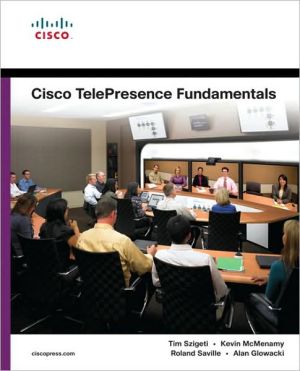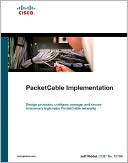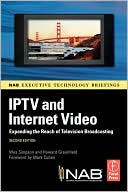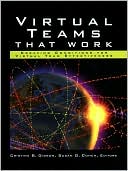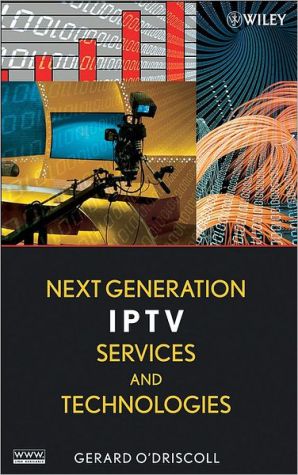Cisco TelePresence Fundamentals (Fundamentals Series)
Cisco TelePresence™ Systems (CTS) create live, face-to-face meeting experiences, providing a breakthrough virtual conferencing and collaboration experience that transcends anything previously achievable by videoconferencing. Although the business case for deploying CTS is compelling, implementing it requires advanced knowledge of the latest networking technologies, an attention to detail, and thorough planning. In this book, four leading CTS technical experts cover everything you need to know...
Search in google:
Cisco TelePresence™ Systems (CTS) create live, face-to-face meeting experiences, providing a breakthrough virtual conferencing and collaboration experience that transcends anything previously achievable by videoconferencing. Although the business case for deploying CTS is compelling, implementing it requires advanced knowledge of the latest networking technologies, an attention to detail, and thorough planning. In this book, four leading CTS technical experts cover everything you need to know to successfully design and deploy CTS in your environment.The authors cover every element of a working CTS solution: video, audio, signaling protocols and call processing, LAN and WAN design, multipoint, security, inter-company connectivity, and much more. They deliver start-to-finish coverage of CTS design for superior availability, QoS support, and security in converged networks. They also present the first chapter-length design guide of it’s kind detailing the room requirements and recommendations for lighting, acoustics, and ambience within various types of TelePresence rooms.Cisco Telepresence Fundamentals is an indispensable resource for all technical professionals tasked with deploying CTS, including netadmins, sysadmins, audio/video specialists, VoIP specialists, and operations staff. This is the only book that: Introduces every component of a complete CTS solution and shows how they work together Walks through connecting CTS in real-world environments Demonstrates how to secure virtual meetings using Cisco firewalls and security protocols Includes a full chapter on effective TelePresence room design Walks through every aspect of SIP call signaling design, including both single-cluster and intercluster examples for use in a TelePresence environment Provides prequalification, room, and network path assessment considerations to help you anticipate and avoid problemsTim Szigeti, CCIE® No. 9794, technical leader within the Cisco® Enterprise Systems Engineering team, is responsible for defining Cisco TelePresence network deployment best practices. He also coauthored the Cisco Press book End-to-End QoS Network Design. Kevin McMenamy, senior manager of technical marketing in the Cisco TelePresence Systems Business Unit, has spent the past nine years at Cisco supporting IP videoconferencing, video telephony, and unified communications. Roland Saville, technical leader for the Cisco Enterprise Systems Engineering team, tests and develops best-practice design guides for Cisco TelePresence enterprise deployments. Alan Glowacki is a Cisco technical marketing engineer responsible for supporting Cisco TelePresence customers and sales teams. Use Cisco TelePresence Systems (CTS) to enhance global teamwork and collaboration, both within your own enterprise and with your customers, partners, and vendors Understand how the various components of the Cisco TelePresence Solution connect and work together Integrate CTS into existing LAN, enterprise, and service provider networks Successfully design and deploy a global TelePresence network Understand the importance of room dimensions, acoustics, lighting, and ambience and how to properly design the physical room environment Provide the high levels of network availability CTS requires Leverage the Cisco quality of service (QoS) tools most relevant to CTS network provisioning and deployment Systematically secure CTS using TLS, dTLS, sRTP, SSH, and Cisco firewallsThis book is part of the Cisco Press® Fundamentals Series. Books in this series introduce networking professionals to new networking technologies, covering network topologies, sample deployment concepts, protocols, and management techniques.Category: IP CommunicationsCovers: Cisco TelePresence Systems
Cisco TelePresence FundamentalsCisco TelePresence FundamentalsIntroduction\ I well remember my first Cisco TelePresence experience.\ It was in the fall of 2006, and my manager had been urging me for several weeks to check out the first pair of production TelePresence rooms at the Executive Briefing Center at the Cisco headquarters in San Jose. However, I had kept putting it off because I was “too busy.” Being familiar with many forms and flavors of video conferencing systems, I was a bit skeptical that there was really anything new or cool enough to merit my walking seven buildings over and seeing for myself. But eventually I relented and made the arduous ten-minute trek, and my life hasn’t been the same since.\ It’s difficult to encapsulate in words how authentic TelePresence is; it just has to be experienced firsthand to really “get it.” But I distinctly remember looking at a life-size image of a colleague on the high-definition screen and seeing the second hand on his watch tick in real time and thinking, “This can change everything.” And indeed it has and is continuing to do so.\ The Cisco company vision has been and continues to be, “changing the way we work, live, play, and learn,” and never has a single technology (since perhaps IP itself) had such a cross-functional impact and potential as Cisco TelePresence.\ TelePresence quite literally changes the way we work. I can personally attest to this because for the past decade, I had been traveling on average two to three times per month: wasting hundreds of hours in airport lines and lounges, spending tens of thousands of company dollars per year, and burning who knows how many tons of fossil fuels. Now, I walk to the nearest TelePresence room and conduct meetings with colleagues and customers alike and then walk home, simultaneously saving time, money, and the environment.\ TelePresence is also changing the way we live. For instance, many Cisco employees usually have at least some members of their families living far away from them. In recent years, during holiday seasons, Cisco has invited employees and their families to book their respectively nearest TelePresence rooms (of which several hundred have been deployed globally) and “visit” with each other. Ongoing research and development is aimed at bringing TelePresence into the home, which would bring all of us closer to our distant friends and families, without having to even leave the couch.\ Similarly, TelePresence is changing the way we play. Recent initiatives in the sports and entertainment fields have seen the introduction of TelePresence in various sports venues, allowing for distant friends to “trash talk” while watching a game or for fans to “visit” with their heroes, even though distances of thousands of miles might physically separate the parties.\ And finally, TelePresence is changing the way we learn. Geographically disparate teachers and students are meeting and interacting with a degree of ease and effectiveness as never before. Classrooms on opposite ends of the planet are linked together through TelePresence, giving students a broader cultural exposure and a better global perspective.\ And the list of ways TelePresence technologies can be applied goes on and on....\ And so, in short, I was hooked. Soon after, I was honored and excited to join a cross-functional team of experts, including Kevin, Roland, Alan, and many others, who were tasked with researching and developing Cisco TelePresence solutions.\ Shortly thereafter, a social incident further underscored to me the universal appeal of TelePresence. For years, my wife and I had an understanding that at dinner parties, if people asked me what I do, I was permitted to reply with “I’m in computers” and leave it at that. If I was pressed, I could expand with “I design networks for computers,” but no further. Otherwise, according to her, if I launched into the technical details of my day-to-day work (which I always thought was interesting), people’s eyes would glaze over with sheer boredom, and they would politely nod with feigned interest, and secretly wish they never asked, and made quick mental notes never to invite us again. However, one evening, after having been assigned to work on TelePresence designs for about a year, I found myself at a dinner party with an elderly gentleman next to me asking me what I did. I replied with the usual permitted one-liner, but as he pressed me for more, I quickly glanced at my wife, saw the shooting look of warning in her eye, gathered up some courage, and defiantly began launching into the detailed work we had been doing on TelePresence. To my amazement, he seemed not only interested, but also excited about some of the possibilities for TelePresence. And it wasn’t long before the whole table of eight began joining in the animated conversation, talking about TelePresence solutions and potentials at length, at the end of which, I shot a triumphantly victorious look back at my wife, and the rules have been permanently relaxed since.\ Back at work, our team immediately started doing research and testing to publish a series of technical papers on best practices for deploying TelePresence systems, and only then did we really begin to grasp how many layers of technology were actually involved in TelePresence solutions, from audio to video to codecs to networks to firewalls to border controllers and so on and so forth. The papers became longer and longer, and we then recognized that having a single depository of such technical information would require a book. And after nearly two more years of work, you hold the result in your hands.\ Objectives and Approach\ The objectives of this book are to introduce you to Cisco TelePresence technologies, both at a conceptual level and at a technical design and deployment level.\ To realize this objective, this book is divided into three main parts:\ \ The first introduces and overviews Cisco TelePresence systems.\ The second delves into the concepts of the various technologies that comprise TelePresence systems and networks.\ The third details best practice design recommendations on how these technologies are integrated and optimally deployed as comprehensive Cisco TelePresence solutions.\ \ Upon completion, you should have a solid working knowledge of Cisco TelePresence systems and technologies and thus can confidently design, deploy, operate, and manage Cisco TelePresence solutions.\ Who Should Read This Book?\ The primary group of readers for this book would be technical staff tasked with deploying Cisco TelePresence systems. These might include network administrators, systems administrators, audio/video specialists, VoIP specialists, and operations staff.\ A secondary group of readers would be technical decision makers tasked with evaluating the business value and technical feasibility of deploying Cisco TelePresence systems.\ A tertiary group of readers would be system engineers, partners, trainers, and other networking professionals who might need to ramp-up technically on Cisco TelePresence systems, with the objective of selling or educating others on these systems.\ How This Book Is Organized\ This book is organized in such a manner that it can be read cover-to-cover and be used as a quick reference guide to specific technical information and design recommendations.\ The content is broken into three main sections: the first section introduces Cisco TelePresence; the second section expands on the various technologies that play a role in TelePresence systems and networks; and the third section describes the Cisco validated best practice recommendations to optimally deploy TelePresence solutions.\ The two chapters comprising Part 1, “Introducing Cisco TelePresence,” cover the following topics:\ \ Chapter 1, “What Is TelePresence”: This chapter introduces Cisco TelePresence, by tracing the evolution of video communications from the 1964 World’s Fair to 2006, when Cisco released their first TelePresence system, which featured state-of-the-art technologies designed to transport high-definition audio and video, in realtime, over a converged IP network infrastructure.\ Chapter 2, “Cisco TelePresence Solution Overview”: This chapter overviews the various components that comprise Cisco TelePresence systems and solutions, including the Cisco TelePresence codec (which is the heart of Cisco TelePresence systems), the Cisco 7975 Series IP Phone, the Cisco Unified Communications Manager, the Cisco TelePresence Manager, the Cisco TelePresence Multipoint Switch, and the Cisco TelePresence Intercompany Solution.\ \ The five chapters comprising Part II, “TelePresence Technologies,” discuss the following topics:\ \ Chapter 3, “TelePresence Audio and Video Technologies”: This chapter delves into more detail on how the Cisco TelePresence codec interacts with the high-definition displays and cameras, microphones and speakers, the IP Phones, auxiliary components, and, most importantly, the network. Audio/video encoding and packetization are extensively discussed, as are the effects of latency, jitter, and loss on TelePresence flows.\ Chapter 4, “Connecting TelePresence Systems”: This chapter details how individual components interconnect and interrelate within Cisco TelePresence systems. Additionally, the three main TelePresence deployment models, intracampus, intra-enterprise and Intercompany, are described.\ Chapter 5, “Network Availability Technologies”: This chapter presents a foundational context for the best practice designs detailed in Chapter 9, “TelePresence Network Design Part 1: Availability Design,” by introducing concepts and metrics relating to network availability for TelePresence deployments. A broad spectrum of availability technologies are overviewed, including device, network, and operational availability technologies.\ Chapter 6, “Network Quality of Service Technologies”: This chapter lays a base for the validated designs detailed in Chapter 10, “TelePresence Network Design Part 2: QoS Design,” by introducing concepts and metrics relating to network quality of service for TelePresence deployments. Various quality of service tools are overviewed, including classification, marking, policing, shaping, queuing, and dropping tools.\ Chapter 7, “TelePresence Control and Security Protocols”: This chapter provides background for the the designs detailed in Chapter 11, “TelePresence Firewall Design,” and Chapter 12, “TelePresence Call-Signaling Design,” by introducing concepts and technologies relating to signaling, control, and security design for TelePresence deployments.\ \ The technical substance of this book is in the second half, specifically in the seven chapters comprising Part III “TelePresence Solution Design,” which detail the following topics:\ \ Chapter 8, “TelePresence Room Design”: This chapter describes topics that are rarely covered in Cisco Press books and that many networking professionals might be unfamiliar with but nonetheless are critical to properly designing rooms to support Cisco TelePresence, including wall, floor, and ceiling surfaces; lighting and illumination; acoustics; and heating, ventilation, air-conditioning. and power.\ Chapter 9, “TelePresence Network Design Part 1: Availability Design”: This chapter details network considerations, targets, and design recommendations for highly available TelePresence networks. Campus designs include virtual switch designs and both EIGRP- and OSPF-routed access designs; branch designs include both dual-tier and multitier branch profiles.\ Chapter 10, “TelePresence Network Design Part 2: QoS Design”: This chapter details network considerations, targets, and design recommendations for QoS-enabled TelePresence networks. The service level requirements of TelePresence are specified in terms of bandwidth, burst, latency, jitter, and loss. QoS designs for campus networks are detailed, as are WAN/branch and MPLS VPN networks.\ Chapter 11, “TelePresence Firewall Design”: This chapter outlines firewall design options for TelePresence deployments. Protocol requirements are examined for TelePresence scheduling, signaling, media, and management flows.\ Chapter 12, “TelePresence Call-Signaling Design”: This chapter examines TelePresence call-signaling components, including the Cisco Unified Communications Manager, Cisco Unified Border Element and Cisco Session Border Controller, and TelePresence signaling operation and design.\ Chapter 13, “Multipoint TelePresence Design”: This chapter expands the complexity of TelePresence deployments by introducing the Cisco TelePresence Multipoint Switch, which enables up to 48 TelePresence segments to be joined together in a single conference. Additionally, this chapter examines the network design implications of TelePresence multipoint deployments.\ Chapter 14, “Inter-Company TelePresence Design”: This chapter applies Metcalfe’s Law to TelePresence deployments by introducing a solution that enables one business to place TelePresence calls to another, namely the Cisco TelePresence Inter-Company Solution. The end-to-end requirements of this solution are specified, including quality, security, scalability, and reliability. The components of the Inter-Company solution are analyzed, with emphasis on the Cisco Session Border Controller and Cisco Unified Border Element. Additionally, the network architecture and security of the Inter-Company solution are examined in depth.\ \ Finally, this book concludes with the Appendix, “Protocols Used in Cisco TelePresence Solutions.” This appendix summarizes and details the many network protocols used by Cisco TelePresence Systems.\ Tim Szigeti March 2009\ © Copyright Pearson Education. All rights reserved.
ContentsIntroduction xixPart I: Introducing Cisco Telepresence 3Chapter 1 What Is Telepresence? 5Evolution of Video Communications 5It’s All About the Experience! 9How Is TelePresence Different Than Video Conferencing? 11Quality 12Simplicity 13Reliability 13Bandwidth Requirements 14Chapter 2 Cisco TelePresence Solution Overview 17The Cisco TelePresence Solution 17Cisco TelePresence Codec 18Industry-Leading Audio and Video 20Video Resolution and Compression Formats 21Audio Resolution and Compression Formats 23Collaboration Tools 24Audio and Video Multiplexing 25Cisco 7975 Series IP Phone 25Cisco TelePresence System 3000 26Three Native 1080p High-Definition Cameras 27Three 65-Inch High-Definition Plasma Displays 27Purpose-Built Meeting Table, Integrated Projector, and Lighting Shroud 28Multichannel Wide-Band Audio 29Cisco TelePresence System 3200 29Extended Camera Focal View 30Second Row Seating 30Extension of Each Table Segment 31Optional Displays for Shared Content 31Cisco TelePresence System 1000 32One Native 1080p High-Definition Camera 33One 65-Inch High-Definition Plasma Display 33Integrated Lighting Shroud 33One Wide-band Microphone and Speaker 34Cisco TelePresence System 500 34One Native 1080p High-Definition Camera 34One 37-Inch High-Definition LCD Display 34Integrated Lighting Shroud 36Integrated Wideband Microphone and Speaker 36Multiple Configuration Options 36Cisco Unified Communications Manager 36Cisco TelePresence Manager 38Calendaring Integration and Management 38One-Button-to-Push Meeting Access 38Resource and Location Management for Cisco TelePresence Multipoint Switch 39CTS System Management and Reporting 41Concierge Services 41Cisco TelePresence Multipoint Switch 42Cisco TelePresence Inter-Company 43Operation, Administration, and Monitoring 45Related TelePresence Services 47Cisco TelePresence Planning, Design, and Implementation 47Cisco TelePresence Essential Operate Service 49Cisco TelePresence Select Operate and TelePresence Remote Assistance Service 49Part II: Telepresence Technologies 53Chapter 3 TelePresence Audio and Video Technologies 55Codec Design Requirements 55Codec System Architecture 56Codec Physical Design 56Master and Slave Codec Architecture 56Codec Operating System Software 59Encoding and Packetization 61Camera and Auxiliary Video Inputs 62Video Encoding 63Audio Encoding 68Real-Time Transport Protocol 70TelePresence Packet Rates 73Depacketization and Decoding 77Managing Latency, Jitter, and Loss 77Summary of Latency, Jitter, Loss Targets and Thresholds,and Actions 82Demultiplexing and Decoding 83Audio-Only Participants 87Dual-Tone Multi-Frequency 89RFC 2833 90Key-Pad Markup Language 90Other Protocols 90How DTMF Tones Are Processed in Cisco TelePresence 91Interoperability with Out-of-Band Collaboration Applications 92Interoperability with Video Conferencing 92Interoperability RTP Channels 93Chapter 4 Connecting TelePresence Systems 99Internal TelePresence System Connections 99Connecting a CTS-500 System 99Connecting a CTS-1000 System 100Connecting a CTS-3000 System 101Connecting a CTS-3200 System 104TelePresence Network Interaction 106TelePresence Network Deployment Models 111Intracampus Deployment Model 112Intra-Enterprise Deployment Model 112Intercompany Deployment Model 114TelePresence Phases of Deployment 116Chapter 5 Network Availability Technologies 121Network Availability 121Device Availability Technologies 125Stackwise/Stackwise Plus 126Nonstop Forwarding with Stateful Switchover 128Network Availability Protocols 132L2 Network Availability Protocols 132L3 Network Availability Protocols 147Operational Availabilities Technologies 155Generic Online Diagnostics 156Chapter 6 Network Quality of Service Technologies 161Modular QoS Command-Line Interface 161Classification Tools 162Class Maps 162Network Based Application Recognition 163Marking Tools 165Ethernet 802.1Q/p CoS 165MPLS EXP 166Differentiated Services Code Points 167Policing Tools 172Single-Rate Policers 173Dual-Rate Policers 174Shaping Tools 178Queuing Tools 181CBWFQ 181LLQ 183Hardware Queuing: 1PxQyT 187Dropping Tools 190WRED 192DSCP-Based WRED 193Explicit Congestion Notification 194HQoS 196Chapter 7 TelePresence Control and Security Protocols 203Network Control Protocols 203IEEE 802.1p/Q: VLAN Tagging and CoS 203IEEE 802.1p/Q Utilization Within Cisco TelePresence Networks 205IEEE 802.3af: Power over Ethernet 205Network Time Protocol (NTP) 206Dynamic Host Configuration Protocol (DHCP) 207Signaling Protocols 208Session Initiation Protocol (SIP) 208AXL/SOAP 216JTAPI, TAPI, and CTIQBE 216WebDAV 217LDAP 217Network Management Protocols 217Cisco Discovery Protocol 218Trivial File Transfer Protocol (TFTP) 222Simple Network Management Protocol 223TelePresence Security Protocols 226Transport Layer Security (TLS) 226Secure Real-Time Transport Protocol (sRTP) 228Bandwidth Impact of Enabling TelePresence Encryption 232Secure Shell (SSH) 232Secure Hypertext Transfer Protocol (HTTPS) 233Part III: Telepresence System Design 237Chapter 8 TelePresence Room Design 239Room Dimensions, Shape, and Orientation 239Width Requirements 240Depth Requirements 245Height Requirements 249Angles, Shape, and Orientation 253Doors and Windows 258Wall, Floor, and Ceiling Surfaces 259Wall Surfaces 259Flooring Surfaces 262Ceiling Surfaces 263Lighting and Illumination 265Considering Light Angles and Direction 266Considering Light Color Temperature 266Measuring Light Intensity 269Light Fixture and Bulb Considerations 271Light Fixture Ballast Considerations 275Acoustics 276Measuring Ambient Noise 277Measuring Reverberation 279Targeted and Maximum Ambient Noise and Reverberation Levels 281Controlling Ambient Noise and Reverberation Levels 281Scenarios for Mitigating Ambient Noise and Reverberation 283HVAC 283HVAC Air Noise Diffusion Considerations 289Power Requirements 290Network Connectivity 294Chapter 9 TelePresence Network Design Part 1: Availability Design 297TelePresence Availability Considerations and Targets 297Highly Available Campus Design for TelePresence 299Redundancy 300Hierarchy 301Modularity 303Multitier Campus Distribution Block Design 304Virtual Switch Campus Distribution Block Design 307Routed Access Campus Distribution Block Design 311Highly Available Branch Designs for TelePresence 330Dual-Tier Branch Profiles 331Multitier Branch Profiles 333Chapter 10 TelePresence Network Design Part 2: Quality of Service Design 339TelePresence QoS Considerations 339TelePresence Service Level Requirements 339TelePresence DiffServ Strategy 349Campus QoS Design for TelePresence 356Catalyst 3560/3750 QoS Design for TelePresence 359Catalyst 4500/4900 QoS Design for TelePresence 366Catalyst 6500 QoS Design for TelePresence 374Branch QoS Designs for TelePresence 381LLQ Versus CBWFQ over the WAN/VPN? 383Branch MPLS VPN QoS Considerations and Design 392Chapter 11 TelePresence Firewall Design 407Cisco Firewall Platforms 407Firewall Deployment Options 409Transparent Versus Routed Mode 409Equal Versus Unequal Interface Security Levels 410Network Address Translation 411Application Layer Protocol Inspection 413TLS Proxy Functionality 413TelePresence Protocol Requirements 413Device Provisioning Flows 414Configuration Download and Device Registration Protocols 416Call Scheduling and Services Flows 419Call Signaling Flows 421Media Flows 421Management Flows 424Example Firewall Configuration 428Chapter 12 TelePresence Call-Signaling Design 435Overview of TelePresence Call-Signaling Components 435CUCM: SIP Registrar and Back-to-Back User Agent 435CTS Endpoints: SIP User Agents 437CTMS: SIP Trunk 437Cisco TelePresence SBC and CUBE: B2BUA and Media Proxy 437Session Description Protocol 438Bandwidth Negotiation 440Media Negotiation 440Other Negotiated Parameters 441CTS Boot Process 441Single-Cluster Call Signaling Examples 443CTS Endpoint Registration 443Call Setup 445Call Termination 448Call Hold 449Intercluster Call Signaling 450Single Enterprise Signaling 450Business-to-Business Signaling 450Chapter 13 Multipoint TelePresence Design 455CTMS Overview 455CTMS Meeting Types 457CTMS Meeting Features 459Multipoint Resources 462Geographical Resource Management 463Quality of Service 463Meeting Security 464Meeting Management 465Audio and Video Flows in a Multipoint TelePresence Design 466Audio in a Multipoint TelePresence Meeting 466Video in a Multipoint TelePresence Meeting 467TelePresence Interoperability 469Network Design Considerations for Multipoint TelePresence 472Deployment Models 472Additional Latency 473Bandwidth Considerations 475Burst Considerations 477Positioning of the CTMS Within the Network 481Placement Within the Campus 481Placement within the Branch 482LAN Switch Platform Considerations 482WAN Circuit Support 483Basic Configuration Requirements for Multipoint TelePresence 484CUCM Configuration Requirements 484CTMS Configuration Requirements 484Chapter 14 Inter-Company TelePresence Design 487End-to-End Application Requirements 488Experience Quality Requirements 488Ease of Use Requirements 489Reliability Requirements 489Security Requirements 489Nonproprietary Requirements 490Scalability Requirements 490Solution Components 490Network Architecture and Security 492Public E.164 Dialing 494Inter-VPN Connectivity 495End-to-End Application-Layer Security 510Inter-Company Deployment Models 517Converged Versus Overlay Access Circuits 518Centralized Inter-Company Access Circuit 518Multiple, Decentralized Inter-Company Access Circuits 523Inter-Company Dialing Models 528Scheduling Inter-Company Meetings 531Multiple Service Provider Peering 533Appendix Protocols Used in Cisco TelePresence Solutions 539TOC, 9781587055935, 5-4-09
